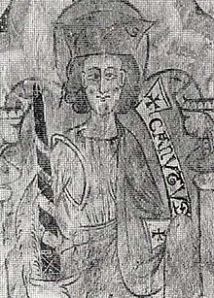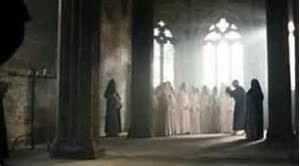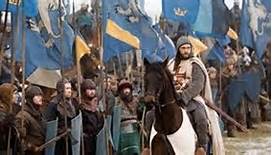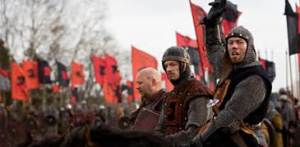Tags
Arn the Knight Templar, Joakim Natterqvist, Knights Templar, Medieval Europe, Monks and Nuns, Religious Issues, Scandinavia
In my last post, I talked about the Holy Land portions of Arn the Templar Knight. In this post, I’m going to focus on the Sweden portions of the film. In order to understand what’s going in Sweden in this film, we need to look a little bit at 12th century Swedish history. Swedish history in this period is particularly complex and turbulent, so I may have gotten some of the small details wrong—the books on Scandinavian history in my personal library weren’t a lot of help on this topic.
12th Century Sweden: Folkungs vs Sverkers
Much of the Swedish action in the film is based around the districts of Västergotland, particularly the Cistercian monastery of Varnhem, and Ostragotland in central Sweden. The two most powerful families were the Eriks and the Sverkers, whose members struggled for control of the throne throughout the later 12th century; the Eriks enjoyed the support of the Folkungs of Ostragotland. In 1160, King Erik the Saint (Erik IX) was murdered, reportedly by Emund Ulvbane, a supporter of the Sverker dynasty. Power passed to Karl Sverkersson (Charles VII).
While Karl held the throne, Erik’s son, Knut Eriksson went into exile and his wife, whose name is unknown, was placed in a convent to protect her. In 1167, Karl Sverkersson was assassinated by Knut’s supporters, and Knut became king (Knut I) (and was reunited with his wife), although he struggled with Karl’s sons for 6 years before he was entirely in control of Sweden. His most important supporter was his jarl, Birger Brosa (“Smiling Birger”). He remained king until 1196, when he fell ill and died. But his sons were only minors, and so he was succeeded by Sverker II, son of Karl Sverkersson.
After his father’s death, Sverker was taken to Denmark to be raised among his Danish mother’s clan. When Knut died, Birger Brosa and other Swedish leaders brokered Sverker’s peaceful succession. In 1203, Sverker exiled Karl’s sons from Sweden. They returned in 1205 with Norwegian backing, but Sverker killed three of them and drove the fourth, Erik, out of the country. Erik returned again in 1208, and confronted Sverker at the battle of Lena. Sverker’s troops were commanded by his father-in-law, Ebbe Suneson, but Erik defeated them, drove Sverker out of Sweden, and became king (Erik X). In 1210, Sverker attempted an invasion but was killed at the battle of Gestilren.
By the 1240s, the dominant figure in Sweden was Birger Jarl, who was a great-grandson of Sverker I and nephew of Birger Brosa, thus straddling the divide between these two important families. After defeating a branch of the Folkungs at the battle of Sparrsätra (which involved the first documented use of cavalry in Sweden), he was able to orchestrate the election of his son Valdemar I as king of Sweden, although Birger Jarl remained the power behind the throne until his death in 1266. Valdemar reigned until 1275, when he was deposed by his younger brother, but in many ways, Valdemar’s reign saw the emergence of a fully-unified Sweden.
With all that in mind, let’s get to Arn the Knight Templar
The Opening of the Film
At the start of the film, Arn is given to the Cistercian monastery of Varnhem, in Västergotland, at age 5 after he falls sick and his mother prays for his recovery. He is raised by the monks there, and receives military training from Brother Guilbert, a former Templar. But as a young adult, the abbot Father Henry (Simon Callow) sends Arn (Joakim Nätterqvist) back to his family, who happen to be the Folkungs. He shows up just in time to help Birger Brosa. Birger is trying to achieve a reconciliation with the Sverkers, but the Sverker agent, Emund Ulvbane, insults the Folkungs and maneuvers the elderly Birger into a duel. Arn steps in at the last moment and defeats Emund, initially showing him mercy, but cutting off his hand when Emund treacherously tries to attack him again.
This is a nice example of a fictional character being inserted into a historical conflict. Very little seems to be known about Emund Ulvbane, so having Arn maim him is a nice bit of hypothetical history that doesn’t disrupt the known facts at all.
Arn falls in love with Cecilia Algotsdotter (Sofia Helin). It’s not entirely clear what her situation is at the start of the film. She seems to be in Godhem Convent (along with her sister Katarina), but only part of the time. She’s singing in a choir when Arn walks into the church and sees her.
He falls in love with Cecilia and they sneak off and have sex, and Cecilia gets pregnant. She tells her sister Katarina, who is envious of her because Katarina feels that their father only has the resources to marry off one girl. Katarina fears having to become a nun, so she tells Mother Rikissa (Bibi Andersson), who happens to be a Sverker. Mother Rikissa writes to her cousin the bishop and informs him of what has happened. A plot is hatched in which Katarina claims to have had sex with Arn, which allows the bishop to accuse Arn and Cecilia of fornication and Arn of incest (which in this period included sleeping with two sisters). He excommunicates them and imposes a strict 20 year penance on the lovers; Arn is sent to Varnhem Abbey and Cecilia to Godhem. This establishes the central conflict of the film; Arn has to become a Templar and serve in the Holy Land, while Cecilia has to live at Godhem and endure the torments of the hateful Mother Rikissa. She is saved when Cecilia Blanka arrives at the convent. Blanka is eventually revealed to be the wife of Knut Eriksson and when Knut becomes king, Blanka returns to him and takes Cecilia with him.
But there are various problems with this whole scenario. Just as the film is unclear about how the Templar Order operates, so too is it unclear about everything else about the medieval church. Arn is given to the monastery as a boy; this is clearly supposed to be an example of oblation, in which a child was given by his parents to a monastery to become a monk. But oblation was dying out in the 12th century, and the Cistercians in particular refused to accept them because they found the presence of children disruptive. Furthermore, if he had been given as an oblate, he wouldn’t have been allowed to leave the monastery as an adult. Father Henry seems to be a rather lax Cistercian at a time when Cistercians were known for their strictness.
The abbot’s laxness is also shown in that he allows Brother Guilbert to just stand around practicing archery, and he allows Guilbert to teach Arn to fight, apparently just because Arn is good at fighting. Medieval monks, especially 12th century Cistercians, followed a fairly regimented daily routine that wouldn’t have allowed much room for archery or sword play. Overall, this detail is wildly improbable.
Mother Rikissa is just as lax as Father Henry, because she seems to allow Cecilia to come and go from the abbey at will, and she allows Arn to just walk into the convent for no apparent reason. Noble girls were frequently sent to convents to be raised, but the whole point of that is to help ensure their virginity, which Mother Rikissa distinctly fails to do. The convent also has a male choir director, which would have been extremely inappropriate. But overall, Mother Rikissa is a bigger problem because she’s dressed as a Cistercian even though the Cistercian Order didn’t accept nuns in the 12th century.
The bishop’s punishment of them is also historically dubious. I’ve already dealt with the problem of forcing someone to become a Knight Templar, but that’s only the tip of the iceberg. In church one day, the bishop brings the accusation of fornication and incest against Arn and Cecilia and imposes penance on them right there and then. This is roughly the equivalent of a modern judge calling a press conference to announce that he will prosecute someone for a crime and then declaring the sentence.
Contrary to popular imagination, the medieval Church had a complex body of law (canon law) that governed how a bishop’s court could proceed. In this period, there had to be a formal accuser (who would be punished if the charge could not be proven), and the bishop cannot bring the accusation himself because he or his official acted as the judge and therefore had to be objective (at least in theory). The defendants had to be summoned to appear in the bishop’s court, where a trial would be conducted, with the accused having the ability to defend himself. If found guilty, the bishop can then impose penance, but he can’t impose penance without a trial unless the accused confesses to a sin. Since there has been neither a trial nor a confession, the bishop has no authority to impose penance on Arn and Cecilia. Furthermore, excommunication was a tool to force someone to submit and receive penance; it’s not really a punishment in its own right. There was no point in an excommunicated person performing penance, because excommunication was essentially a threat of damnation, and until the excommunication was lifted, no amount of penance would achieve any spiritual benefit because the person would be going to hell. There was no point in an excommunicated person going on crusade, for just the same reason.
Sentencing Arn and Cecilia to 20 years’ penance at monasteries is probably excessive, but the bishop is evil and out to get Arn and Cecilia, so I suppose this detail is not implausible.
Overall, the film seems to just be making up the religious details as needed for the plot. This is not uncommon in popular films about the Middle Ages. The assumption is made that the Church had enormous and largely unrestricted power which the clergy could exercise or not as they saw fit. In reality, the clergy were as tightly bound by canon law as modern police and lawyers are bound by modern civil law. Some certainly abused their authority, but this was taken as seriously as abuse of power by law enforcement is today.
After Odysseus Arn Returns Home
The last 30 minutes or so of Arn are focused on the period after Arn gets back to Sweden and is reunited with Cecilia. His return must be around 1188 or 1189. Despite Cecilia’s royal connections through Blanka and Arn’s distinguished military career, they go back to peasanting, which mostly consists of throwing nets in shallow creeks, cutting boards, and making love. Personally, if I had important political connections that could lift me out of poverty, I’m pretty sure I’d use them to avoid a life of drudgery and hard labor, but modern movies about the Middle Ages typically emphasize the moral value of simple peasant life over the moral compromises of the nobility.
After this, however, the historical train goes completely off the rails. The time scale seems to collapse here. The villainous Ebbe Suneson shows up and tells them that Knut is dying and Sverker will come to power, so we’ve suddenly jumped to about 1195. We get a training montage of Arn teaching peasants how to fight, and then Arn and his men head off to fight what seems to be the battle of Lena in 1208. The film entirely passes over Sverker’s legitimate and peaceful election as king, as well as the intervening political upheavals. Sverker is supported by Danish troops led by Ebbe Suneson. But I suppose Arn can win the battle because he’s had more than a decade to train them to fight.
The ensuing battle is a mélange of random bits of medieval warfare. Arn’s troops are equipped with chainmail or leather armor, mid-11th century Norman helmets, a mixture of early medieval round shields and 12th century heater shields, and Welsh longbows, which wouldn’t be introduced to the wider European world by the English until the late 13th century. This is the equivalent of equipping Napoleon’s troops with AK-47s. Sverker’s forces include a lot of cavalry (which, remember, wasn’t introduced to Sweden until the 1240s), with everyone in chainmail and great helms (which is about right for the late 12th century).
Arn defeats and kills Ebbe because Ebbe is unfamiliar with the dangers posed to cavalry by the Welsh longbow (understandable given that he couldn’t have ever seen them before). The battle itself is staged as a mixture of the battle of Agincourt in 1415 and Braveheart’s version of the battle of Stirling Bridge, and probably bears no actual resemblance to the battle of Lena.
Arn is wounded in the battle and dies after returning home to Cecilia. The film concludes with a shot of his funeral, and an epilogue text explaining that Arn’s efforts brought peace to Sweden for many years and that Arn was the reason Sweden was unified. The novels position Arn as the grandfather of Birger Jarl, but in asserting that Sweden’s peace and unification was brought about because of Arn, the film essentially passes from historical fiction into alternate history. It’s sort of like ending Saving Private Ryan with an epilogue that explains that the US won World War II because of Captain America.
To my mind, the film is at its best when it’s focusing on Sweden. It explores a largely neglected period of history and introduces high medieval Sweden to a wider audience. But unfortunately, it doesn’t clearly explain the historical conflict it’s using as its backdrop and instead resorts of clichés about the Middle Ages that obscure more than they educate. Perhaps the fuller, two-film version does a better job explaining the history it’s working with. So while Arn the Knight Templar is a decent story, it’s very muddled history.
Want to Know More?
Arn: The Knight Templaris available on Amazon.
As I mentioned, it’s based on Jan Guillou’s Crusades trilogy: The Road to Jerusalem: Book One of the Crusades Trilogy; The Templar Knight: Book Two of the Crusades Trilogy; and Birth of the Kingdom: Book Three of the Crusades Trilogy












Uh, I don’t mean to be picky here, but I am pretty sure America DID win World War II because of Captain America.
See?
LikeLike
And that is exactly the logic some of my students use…
LikeLike
Pingback: Ironclad: Vikings, and Templars, and Magna Carta, Oh My! | An Historian Goes to the Movies
Pingback: Hercules: When the Mythical and the Historical Collide | An Historian Goes to the Movies
Pingback: Amadeus: Strange but True | An Historian Goes to the Movies
A good and thoughtful article, and I like to share some thoughts re: the following photo caption: “Why is there a male choir director in a house of nuns?” Possible answer: Medieval convents and women’s monasteries DID allow men to enter into certain parts of the enclosure, under certain circumstances. Their priest and confessor for example might very well have also been their music director. Male monastics had greater leeway with traveling than did females. Information re: new modes of chanting, updates to hymnals and breviaries, etc. were brought into female monastic houses by men. Another possible reason why the choir director is male: for several centuries, there were dual sex monastic houses in Europe. Monks and nuns occupied and used the same buildings, each with their own “half”, though there was some intermingling. After dual sex communities died out in England, France and elsewhere, they remained popular in, and had a revival in the 14th century in – Sweden!
Also, in your article, you express surprise that Arn could just walk into the nun’s chapel. A possible explanation: Medieval monastic chapels and churches were often open to those living around the monastery, serving as parish churches. Monks at one English monastery became so annoyed with the chatting of laity during services, that they built a wall, dividing the church building in two!
LikeLike
Yes, you are correct. Female houses were not 100% exclusive to women. Priests and confessors did have access because those were roles that women could not perform (at least not after about the 7th century), but choir director is not a sacramental role, so there would not have been any reason to not have one of the nuns perform that role.
Dual monasteries were very common in the early Middle Ages, but few of them survived the Viking raids. Later a few orders like the Gilbertines in England experimented with them. But in the 12th century, none of the major orders had dual houses.
The real issue here is the film just genuinely has no idea how monastic houses function.
LikeLike
Pingback: Arn the Knight Templar: Crusading Swedes | An Historian Goes to the Movies
Pingback: The Physician: Getting More Things Wrong | An Historian Goes to the Movies
Pingback: Robin Hood: A Whole Lotta Plot Going On | An Historian Goes to the Movies
Pingback: The Last Kingdom: the Law, the Church, and Marriage | An Historian Goes to the Movies
I appreciate your essays on this film having just watched it last evening. My instinct was to do some reading….quick!…and not allow the suggestions of the screen to insinuate themselves in my memory as any sort of fact. I found myself wondering what the movie-story might whisper through its religious-social-political depictions, especially to the people of Sweden.
LikeLike
There was a typo in my webpage address above. My apologies
LikeLike
Interesting notes. I have a question about the bows. How can you see that they are welsh longbows? Longbows had been in use many centuries before Crecy or Agincourt. The vikings used strong lowbows built fpr war several hundred years before the battle in the movie. They were probably not as string as enlgish/welsh longbows in the late medieval period, but capable enough to shoot about 200 m.
LikeLike
I forgot to mention the AK-47 comment. I don’t think that metaphor is fair. The evolution of firearms between Waterloo and 1947 was considerably faster than that of longbows in the middle ages.
You are perfectly right about the swedish cavalry and heater shields though.
LikeLike
There is some debate about whether longbows were used before the late 12th century in Wales. One very respected historian of medieval warfare–Bernard Bachrach–feels they were used in the early Middle Ages, but so far as I know, other historians have not really accepted his argument yet. Since I haven’t chased down the scholarship Bachrach is drawing from, I’m going to go with the traditional scholarly consensus on this issue.
LikeLike